Woman's Christian Temperance Union
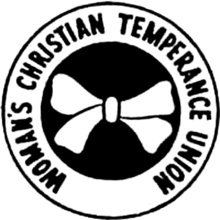
The Woman's Christian Temperance Union (WCTU) is an active temperance organization that was among the first organizations of women devoted to social reform with a program that "linked the religious and the secular through concerted and far-reaching reform strategies based on applied Christianity."[1] It was influential in the temperance movement, and supported the 18th Amendment.
The WCTU was originally organized on December 23, 1873, in Hillsboro, Ohio, and officially declared at a national convention in Cleveland, Ohio in 1874.[2] It operated at an international level and in the context of religion and reform, including missionary work and woman's suffrage. Two years after its founding, the American WCTU sponsored an international conference at which the International Women's Christian Temperance Union was formed.[3] The World's Woman's Christian Temperance Union was founded in 1883 and became the international arm of the organization.
History and purpose
At its founding in 1874, the stated purpose of the WCTU was to create a "sober and pure world" by abstinence, purity, and evangelical Christianity.[4] Annie Wittenmyer was its first president.[5] The constitution of the WCTU called for "the entire prohibition of the manufacture and sale of intoxicating liquors as a beverage."[6]
Frances Willard, a noted feminist, was elected the WCTU's second president in 1879 and Willard grew the organization to be the largest organization of women in the world by 1890. She remained president until her death in 1898.
Its members were inspired by the Greek writer Xenophon, who defined temperance as "moderation in all things healthful; total abstinence from all things harmful." In other words, should something be good, it should not be indulged in to excess; should something be bad for you, it should be avoided altogether — thus their attempts to rid society of what they saw (and still see) as the dangers of alcohol.[7]
The WCTU perceived alcohol as a cause and consequence of larger social problems rather than as a personal weakness or failing. The WCTU also agitated against tobacco. The American WCTU formed a "Department for the Overthrow of the Tobacco Habit" as early as 1885 and frequently published anti-tobacco articles in the 1880s. Agitation against tobacco continued through to the 1950s.[7]

As a consequence of its stated purposes, the WCTU was very interested in a number of social reform issues, including labor, prostitution, public health, sanitation, and international peace. As the movement grew in numbers and strength, members of the WCTU also focused on suffrage. The WCTU was instrumental in organizing woman's suffrage leaders and in helping more women become involved in American politics. Local chapters, known as “unions”, were largely autonomous, though linked to state and national headquarters. Willard pushed for the "Home Protection" ballot, arguing that women, being the morally superior sex, needed the vote in order to act as "citizen-mothers" and protect their homes and cure society's ills. At a time when suffragists were viewed as radicals and alienated most American women, the WCTU offered a more traditionally feminine and 'appropriate' organization for women to join.
Although the WCTU had chapters throughout North America with hundreds of thousands of members, the "Christian" in its title was largely limited to those with an evangelical Protestant conviction and the importance of their role has been noted. The goal of evangelizing the world, according to this model, meant that very few Catholics, Jews, Muslims, Buddhists or Hindus were attracted to it, "even though the last three had a pronounced cultural and religious preference for abstinence".[8] As the WCTU grew internationally, it developed various approaches that helped with the inclusion of women of religions other than Christianity. But, it was always primarily, and still is, a Christian women's organization.
Policy interests
The WCTU's work extended across a range of efforts to bring about personal and social moral reform. In the 1880s it worked on creating legislation to protect working girls from the exploitation of men, including raising Age of Consent laws.[9] It also focused on keeping Sundays as Sabbath days and restrict frivolous activities. In 1901 the WCTU said that golf should not be allowed on Sundays.[10]
The WCTU also wanted to aid immigrants coming into the United States through "Americanization" activities. Between 1900 and 1920, much of their budget was given to their center on Ellis Island, which helped to start the Americanization process. The WCTU promoted the idea that immigrants were more prone to alcoholism than native Americans, focusing particularly on Irish and German immigrant communities as the source of the problem.
The WCTU was also concerned about trying to alleviate poverty, through abstinence from alcohol. Through journal articles, the WCTU tried to prove that abstinence would help people move up in life. A fictional story in one of their journal articles illustrates this fact:
Ned has applied for a job, but he is not chosen. He finds that the potential employer has judged him to be like his Uncle Jack. Jack is a kindly man but he spends his money on drink and cigarettes. Ned has also been seen drinking and smoking. The employer thinks that Ned Fisher lacks the necessary traits of industriousness which he associates with abstinence and self control.[9]
Spread and influence
The Woman’s Christian Temperance Union grew rapidly. The WCTU adopted Willard's ‘Do Everything’ philosophy which meant that the “W.C.T.U. campaigned for local, state, and national prohibition, woman suffrage, protective purity legislation, scientific temperance instruction in the schools, better working conditions for labor, anti-polygamy laws, Americanization, and a variety of other reforms”[11] despite having the image of a gospel temperance organization. The presidential addresses of the WCTU provide excellent insight as to how the organization seamlessly blended issues of grass-roots organizing, temperance, education, immigration and cultural assimilation.
One prominent state chapter was the Minnesota Women’s Christian Temperance Union. The Minnesota chapter’s origin is rooted in nation’s anti-saloon crusades of 1873 and 1874 where women all throughout the United States “joined together outside saloons to pray and harass the customers.”[11] In Minnesota there was stiff resistance to this public display and “in Anoka, Minnesota, ‘heroic women endured the insults of the saloon-keeper and his wife who poured cold water upon the women from an upper window while they prayed on the sidewalk below. Sometimes beer was thrown on the sidewalk so that they could not kneel there but they prayed.’”[11] As a result Minnesotan women were motivated and “formed local societies, which soon united to become the National Woman's Christian Temperance Union in 1874. Women from St. Paul, Minneapolis, Red Wing, and Owatonna organized their first local W.C.T.U. clubs between 1875 and 1877. The Minnesota W.C.T.U. began in the fall of 1877”[11] From this point the Minnesota WCTU began to expand throughout the state in both size and interests.
The Minnesota WCTU worked hard to extoll the values of the WCTU which included converting new immigrants to American culture or “Americanization.” Bessie Laythe Scovell, a native New Englander that moved to Minnesota in the 1800s and served as president of the Minnesota WCTU chapter from 1897–1909 delivered her 1900 “President’s Address”, where she expounded on the methods the Minnesota chapter of the WCTU would utilize to accomplish its variety of goals within the state. Scovell adopted what was at the time a “progressive” approach to the issue of immigrants, particularly German and Scandinavian in Minnesota, indulging in alcohol and stated:
“We must have a regiment of American workers, who will learn the German language, love the German people, work among the German children and young people until we get them to love clear brains better than beer. There must be others who for the love of country and dear humanity will learn the Scandinavian language and be real neighbors to the many people of this nationality who have come to make homes in America. Again others must learn the French and Italian and various dialects, even, that the truths of personal purity and total abstinence be taught to these who dwell among us. We must feel it a duty to teach these people the English language to put them in sympathy with our purposes and our institutions.”[12]
For Scovell and the women of the Minnesota WCTU, speaking English and participating in established American institutions were essential to truly become “American” just as abstaining from alcohol was necessary to be virtuous. By linking language to culture and institutions Scovell and the WCTU recognized that a multicultural approach would be necessary to communicate values to new immigrants, but did not conclude that multiculturalism was a value in itself. The WCTU viewed the foreign European cultures as a corrupter and despoiler of virtue, hence the excessive drinking. That is ultimately why it was paramount the immigrants learned English and assimilated.
Reach of the Womans' Temperance Movement
In the United States, the WCTU was divided along ideological lines. The first president of the organization, Annie Wittenmyer, believed in the singleness of purpose of the organization—that is, that it should not put efforts into woman suffrage, prohibition, etc.[13] This wing of the WCTU was more concerned with how morality played a role during the temperance movement. With that in mind, it sought to save those whom they believed to be of lower moral character. For them, the alcohol problem was one of moral nature and was not caused by the institutions that facilitated access to alcohol.
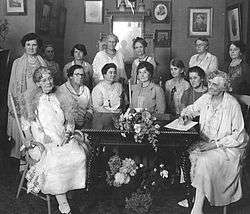
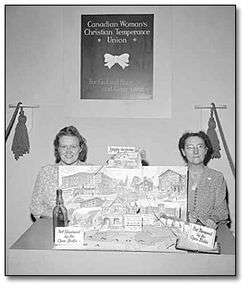
The second president of the WCTU, Frances Willard, demonstrated a sharp distinction from Wittenmyer. Willard had a much broader interpretation of the social problems at hand. She believed in "a living wage; in an eight-hour day; in courts of conciliation and arbitration; in justice as opposed to greed in gain; in Peace on Earth and Good-Will to Men."[14] This division illustrated two of the ideologies present in the organization at the time, conservatism and progressivism. To some extent, the Eastern Wing of the WCTU supported Wittenmyer and the Western Wing had a tendency to support the more progressive Willard view.
Membership within the WCTU grew greatly every decade until the 1940s.[15] By the 1920s, it was in more than forty countries and had more than 766,000 members paying dues at its peak in 1927.[1]
| Years | Membership |
|---|---|
| 1881 | 22,800 |
| 1891 | 138,377 |
| 1901 | 158,477 |
| 1911 | 245,299 |
| 1921 | 344,892 |
| 1931 | 372,355 |
| 1941 | 216,843 |
| 1951 | 257,540 |
| 1961 | 250,000 [16] |
| 1989 | 50,000 (worldwide)[17] |
| 2009 | 20,000 [18] |
| 2012 | 5,000 [19] |
Classification of WCTU Committee Reports by Period and Interests[20]
| Period | Humanitarian Reform | Moral Reform | Temperance | Other | N |
|---|---|---|---|---|---|
| 1879–1903 | 78.6 | 23.5 | 26.5 | 15.3 | 98 |
| 1904–1928 | 45.7 | 30.7 | 33.1 | 18.0 | 127 |
| 1929–1949 | 125.8 | 37.0 | 48.2 | 1.2 | 81 |
- Source:Sample of every fifth Annual Report of the WCTU
Percentages total more than 100 percent due to several interests in some committee reports.
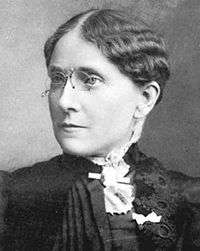
Frances Willard
In 1874 Willard was elected the new secretary of the WCTU. Five years later, in 1879, she became its president. Willard also started her own organization, called the World's Women Christian Temperance Union, in 1883.[21]
After becoming WCTU president, Willard broadened the views of the group by including woman's rights reforms, abstinence, and education. As its president for 19 years, she focused on moral reform of prostitutes and prison reform as well as woman's suffrage. With the passage of the 19th Amendment in 1920, Willard's predictions that women voters "would come into government and purify it, into politics and cleanse the Stygian pool" could be tested.[22] Frances Willard died in February 1898 at the age of 58 in New York City. A plaque commemorating Willard's election to president of the WCTU in 1879 by Lorado Taft is in the Indiana Statehouse, Indianapolis, Indiana.[23]
Matilda Bradley Carse
Matilda B. Carse became an activist after her son was killed in 1874 by a drunk wagon driver. She joined the Chicago Central Christian Woman's Temperance Union to try to eliminate alcohol consumption. In 1878 she became the president of the Chicago Central Christian Woman's Temperance Union, and in 1880 she helped organize the Woman's Temperance Publishing Association, selling the stock to rich women. That same year she also started The Signal; three years later it merged with another newspaper to become The Union Signal.[24]
It became the most important woman's newspaper and soon sold more copies than any other newspaper. During her time as president, Carse founded many charities and managed to raise approximately $60,000,000 a year to support them. She started the Bethesda Day Nursery for working mothers, two kindergarten schools, the Anchorage Mission for erring girls, two dispensaries, two industrial schools, an employment bureau, Sunday schools, and temperance reading rooms.[24]
The World's WCTU
The World's WCTU (WWCTU) is one of the most prominent examples of internationalism, evidenced by the circulation of the Union Signal around the globe; the International Conventions that were held with the purpose of focusing "world attention on the temperance and women's questions,[25] and the appointment of "round-the-world missionaries." Examples of international Conventions include the one in 1893 scheduled to coincide with the Chicago World's Fair; the London Convention in 1895; the 1897 one in Toronto; and the Glasgow one in 1910. The first six round-the-world missionaries were Mary C. Leavitt, Jessie Ackermann, Alice Palmer, Mary Allen West, Elizabeth Wheeler Andrew and Dr Catherine C. Bushnell.[26]
The ambition, reach and organizational effort involved in the work undertaken by the World's WCTU leave it open to cynical criticism in the 21st century, but there is little doubt that at the end of the 19th century, "they did believe earnestly in the efficacy of women's temperance as a means for uplifting their sex and transforming the hierarchical relations of gender apparent across a wide range of cultures."[27]
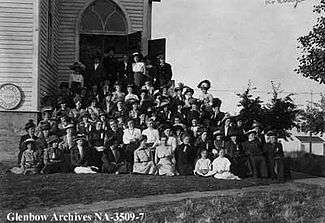
In Canada
The WCTU formed in Canada in 1874, in Owen Sound, Ontario.[28] In 1885 Letitia Youmans founded an organization which was to become the leading women's society in the national temperance movement. One notable member was Edith Archibald of Nova Scotia. Famous Canadian feminist Nellie McClung was also involved.
In Australia
The WCTU began in Australia following visits from Jessie Ackermann in 1889 and 1891; a number of other Christian Temperance and Abstinence Societies existed throughout Australia before that time.[29] Jessie Ackermann acted as the round the world missionary for the American-based World's WCTU, and became the inaugural president of the federated Australasian WCTU, Australia's largest women's reform group.[30] They were active in the struggle for the extension of the franchise to women through promoting suffrage societies, collecting signatures for petitions and lobbying members of parliament. (See, for example, Women's suffrage in Australia.) After visiting New Zealand, Miss Ackermann came to Hobart in May 1889,[31][32] then toured the mainland for almost 12 months, stopping in Adelaide, Port Augusta, Clare, Kapunda and Burra in June to August,[33][34][35] Mount Gambier, Brisbane, Sydney, and Bathurst. She returned for a further visit, including Melbourne in 1891.
In Victoria, weekly temperance conferences were held at the East Melbourne home of Margaret McLean,[36] a founding member and coordinator of the Melbourne branch of the WCTU of Victoria; she was president of the organisation for two periods, 1892–93 and 1899–1907.[37][38]
In New Zealand
Led by Kate Sheppard from 1887, the New Zealand WCTU was a major force behind the campaign for women's suffrage. This resulted in New Zealand women being granted universal suffrage in 1893.[39] Lily May Atkinson was another significant member.
In Sweden
The Swedish WCTU, known as Vita Bandet (White Ribbon) was founded by Emilie Rathou in Östermalm in Stockholm in 1900.[40] Rathou was a leading member of the International Organisation of Good Templars, and the pioneer for organizing the WCTU and its local branches in Sweden.
Prohibition
Over the years different prohibition and suffrage activists had suspected that brewer associations gave money to anti-suffrage activities. In 1919 there was a Senate investigation that confirmed their suspicions. Some members of the United States Brewers Association were openly against the woman's suffrage movement. One member stated, "We have defeated woman's suffrage at three different times."[41]
Although the WCTU was an explicitly religious organization and worked with religious groups in social reform, it protested wine use in religious ceremonies. During an Episcopal convention, it asked the church to stop using wine in its ceremonies and to use unfermented grape juice instead. A WCTU direct resolution explained its reasoning: wine contained "the narcotic poison, alcohol, which cannot truly represent the blood of Christ."[42]
The WCTU also favored banning tobacco. In 1919 the WCTU expressed to Congress its desire for the total abolition of tobacco within five years.[43]
Under Willard, the WCTU supported the White Life for Two program. Under this program, men would reach women’s higher moral standing (and thus become woman's equal) by engaging in lust-free, alcohol-free, tobacco-free marriages. At the time, the organization also fought to ban alcohol use on military bases, in Indian reservations, and within Washington’s institutions.[44] Ultimately, Willard succeeded in increasing the political clout of the organization because, unlike Annie Wittenmyer, she strongly believed that the success of the organization would only be achieved through the increased politicization of its platform
Woman's Temperance Publishing Association
The Woman's Temperance Publishing Association was started in Indianapolis by Wallace but thought up by Matilda B. Carse. They thought there was a need for a weekly temperance paper for women of color. The creators wanted the first board of directors to be seven women who had the same vision as Carse.[45]
Current status
The WCTU remains an internationally active organization.[46] In American culture, although "temperance norms have lost a great deal of their power"[15] and there are far fewer dry communities today than before ratification of the Eighteenth Amendment, there is still at least one WCTU chapter in almost every U.S. state and in 36 other countries around the world.[47]
Requirements for joining the WCTU include paying membership dues and signing a pledge to abstain from alcohol. The pledge of the Southern Californian WCTU, for example, is "I hereby solemnly promise, God helping me, to abstain from all distilled, fermented, and malt liquors, including beer, wine, and hard cider, and to employ all proper means to discourage the use of and traffic in the same."[48] Current issues for the WCTU include alcohol, which the organization considers to be North America's number one drug problem, as well as illegal drugs, abortion[49] and gay marriage.[50] The WCTU has warned against the dangers of tobacco since 1875. They continue to this day in their fight against those substances they see as harmful to society. The WCTU strongly supports banning same-sex marriage, which it sees as a negative influence on families.
The WCTU continues to publish a quarterly journal titled The Union Signal, whose main focus is current research and information on drugs.[51] Other national organizations also continue to publish.[52]
The WCTU also attempts to encourage young people to avoid substance abuse through participation in three age-divided suborganizations: White Ribbon Recruits for pre-schoolers, the Loyal Temperance Legion (LTL) for elementary school children, and the Youth Temperance Council (YTC) for teenagers.
The White Ribbon Recruits are mothers who will publicly declare their dedication to keeping their babies drug-free. To do this, they participate in the White Ribbon Ceremony, but their children must be under six years of age. The mother pledges "I promise to teach my child the principles of total abstinence and purity", and the child gets a white ribbon tied to its wrist.
The Loyal Temperance Legion (LTL), is another temperance group aimed at children. It is for children aged six to twelve who are willing to pay dues annually to the LTL. Its motto is "That I may give my best service to home and country, I promise, God helping me, Not to buy, drink, sell, or give Alcoholic liquors while I live. From other drugs and tobacco I'll abstain, And never take God's name in vain."
The Youth Temperance Council is the final type of group meant for youths and is aimed at teenagers. Its pledge is "I promise, by the help of God, never to use alcoholic beverages, other narcotics, or tobacco, and to encourage everyone else to do the same, fulfilling the command, 'keep thyself pure'."[53]
See also
- Jessie Ackermann
- Anna Adams Gordon
- Mary Hunt
- Louisa Lawson
- List of suffragists and suffragettes
- Margaret Bright Lucas
- Carrie Nation
- Lillian M. N. Stevens
- Scientific Temperance Federation
- Temperance movement
- Timeline of women's suffrage
- Lala Fay Watts
- Ida B. Wise
- Woman's Christian Temperance Union Administration Building
- Woman's Christian Temperance Union Fountain
- Women's suffrage organizations
- Frances Willard
References
Notes
- 1 2 Tyrrell, Ian (1991). Woman's World/Woman's Empire: The Woman's Christian Temperance Union in International Perspective 1880-1930. Chapel Hill and London: The University of Carolina Press. p. 2. ISBN 0-8078-1950-6.
- ↑ Gordon, Elizabeth Putnam (1924). Woman Torch Bearers. Woman Christian Temperance Union. p. 15.
- ↑ Tyrrell, Ian (1991). Woman's World/Woman's Empire: The Woman's Christian Temperance Union in International Perspective 1880-1930. p. 20. ISBN 0-8078-1950-6.
- ↑ Tyrrell, Ian (1991). Woman's World/Woman's Empire: The Woman's Christian Temperance Union in International Perspective 1880-1930. p. 7. ISBN 0-8078-1950-6.
- ↑ "History of the Woman's Temperance Crusade" 1882
- ↑ WCTU 1876, p. 1
- 1 2 Tyrrell, Ian (1999). Deadly Enemies: Tobacco and Its Opponents in Australia. UNSW Press. p. 26. ISBN 0-86840-745-3.
- ↑ Tyrrell, Ian (1999). Deadly Enemies: Tobacco and Its Opponents in Australia. pp. 65–66.
- 1 2 Gusfield, Joseph R. (1955). "Social Structure and Moral Reform: A Study of the Woman's Christian Temperance Union". The American Journal of Sociology'. 61 (3): 223–225.
- ↑ THE W.C.T.U. New York Times April 7, 1901
- 1 2 3 4 How Did the Reform Agenda of the Minnesota Woman's Christian Temperance Union Change, 1878-1917?, by Kathleen Kerr. (Binghamton, NY: State University of New York at Binghamton, 1998). Introduction
- ↑ How Did the Reform Agenda of the Minnesota Woman's Christian Temperance Union Change, 1878-1917?, by Kathleen Kerr. (Binghamton, NY: State University of New York at Binghamton, 1998). Document 2: Bessie Laythe Scovell, "President's Address," Minutes of the Twenty-Fourth Annual Meeting of the W.C.T.U. of the State of Minnesota (St. Paul: W.J. Woodbury, 1900).
- ↑ Gusfield, Joseph R. (1986). Symbolic Crusade: Status Politics and the American Temperance Movement, University of Illinois Press. page 74
- ↑ Gusfield, Joseph R. (1986). Symbolic Crusade: Status Politics and the American Temperance Movement, page 76
- 1 2 Gusfield, Joseph R. (1955). "Social Structure and Moral Reform: A Study of the Woman's Christian Temperance Union". The American Journal of Sociology'. 61 (3): 222.
- ↑ "Double-Do for WCTU". Time magazine. 1961-08-18. Retrieved 2009-04-09.
- ↑ Johnson, Dirk (1989-09-14). "Temperance Union Still Going Strong". New York Times. Retrieved 2009-04-09.
- ↑ Bickel, Amy (2009-09-18). "WILD, WEIRD, WONDERFUL: Union unwavering in 97-year presence". The Hutchinson News. Archived from the original on April 25, 2013. Retrieved 2012-02-15.
- ↑ "Beer at Walker's brat summit raise ire of temperance group". Channel3000.com. 2012-06-12. Retrieved 2012-06-12.
- ↑ Gusfield, Joseph R. (1955). "Social Structure and Moral Reform: A Study of the Woman's Christian Temperance Union". The American Journal of Sociology'. 61 (3): 226.
- ↑ Women Christian Temperance Union. Francis Willard (Evanston, 1996-2008)
- ↑ Kenneth D. Rose, American Women and the Repeal of Prohibition (NYU Press, 1997), 36.
- ↑ Scherrer, Anton. "Our Town." Indianapolis Times. 18 April 1939.
- 1 2 Judy Barrett Litoff, Judith McDonnell.European Immigrant Women in the United States Taylor & Francis, (1994) 51.
- ↑ Tyrrell, Ian (1991). Woman's World/Woman's Empire: The Woman's Christian Temperance Union in International Perspective 1880-1930. p. 49. ISBN 0-8078-1950-6.
- ↑ Frances Willard, Do Everything: A Handbook for the World's White Ribboners [Chicago: Ruby I. Gilbert, 1905] cited in Tyrrell, (1991) Woman's World/ Woman's Empire p. 86
- ↑ Tyrrell, Ian (1991). Woman's World/Woman's Empire: The Woman's Christian Temperance Union in International Perspective 1880-1930. p. 61. ISBN 0-8078-1950-6.
- ↑ Sheehan, Nancy M. "Woman's Christian Temperance Union". Retrieved 2016-09-11.
- ↑ Evening Journal (Adelaide),27 May 1889
- ↑ Tyrrell, Ian. "Ackermann, Jessie A. (1857–1951)". Australian Dictionary of Biography. Australian National University. Retrieved 17 October 2011.
- ↑ Evening Journal (Adelaide), 27 May 1889
- ↑ The Advertiser (Adelaide),27 May 1889
- ↑ "Temperance News", The South Australian Register (Adelaide), 10 June 1889
- ↑ The Port Augusta Dispatch, Newcastle and Flinders Chronicle (SA : 1885 - 1916) Friday 5 July 1889
- ↑ The Kadina and Wallaroo Times (SA : 1888 - 1954) Saturday 6 July 1889 p 4
- ↑ Brown, Basil S. (2004). "MCLEAN, Margaret (1845-1923)". Australian Pentecostal Studies. Retrieved 17 September 2014.
- ↑ Hyslop, Anthea (1986). "McLean, Margaret (1845–1923)". Australian Dictionary of Biography. Retrieved 17 September 2014.
- ↑ Lake, Marilyn; Kelly, Farley (1985). Double Time: Women in Victoria, 150 Years. Penguin. p. 125. ISBN 0140060022. (footnote 4)
- ↑ Atkinson, Neill (2003), Adventures in Democracy: A History of the Vote in New Zealand, University of Otago Press, p.89.
- ↑ Emilie Rathou, urn:sbl:7563, Svenskt biografiskt lexikon (art av Hjördis Levin), hämtad 2015-05-30.
- ↑ Kenneth D. Rose, American Women and the Repeal of Prohibition(NYU Press, 1997),35.
- ↑ "W.C.T.U. ASKS CHURCH TO USE GRAPE JUICE; Episcopal Convention Sends Back Word That It Is Too Late to Consider Question." The New York Times, October 26, 1913
- ↑ "PLAN AMENDMENT TO OUTLAW TOBACCO; W.C.T.U. and Prohibition Workers Getting Ready for a Country-Wide Campaign. BUT KEEPING IT A SECRET Fear It Would Hinder Laws for Prohibition Enforcement, Says Report Offered in Congress." New York Times, August 2, 1919,
- ↑ Murdock, Catherine G: “Domesticating Drink: Women, Men, and Alcohol in America, 1870-1940,” p.22. JHU Press. 2001.
- ↑ Rachel Foster Avery, Transactions of the National Council of Women of the United StatesNational Council of Women of the United States (Washington, D.C., February 22 to 25, 1891)
- ↑ "Woman's Christian Temperance Union homepage". Wctu.org. Retrieved 2012-06-05.
- ↑ "Links to other national WCTUs". Wctumd.org. Retrieved 2012-06-05.
- ↑ Robert P. Addleman (2003-09-29). "WCTU of Southern California". Wctusocal.com. Retrieved 2012-06-05.
- ↑ "Issues". Wctumd.org. Retrieved 2012-06-05.
- ↑ "Internet Archive Wayback Machine". Web.archive.org. 2007-05-29. Archived from the original on May 29, 2007. Retrieved 2012-06-05.
- ↑ "WCTU Publications". Wctu.org. 2008-11-01. Retrieved 2012-06-05.
- ↑ For example, the Woman's Christian Temperance Union of Victoria publishes Annual Convention reports. Melbourne: The Union, 1956-2001.
- ↑ "Youth Temperance Council Pledge". Wctu.org. Retrieved 2012-06-05.
Bibliography
- Constitution, by-laws, and order of business of the Women's Christian Temperance Union. Toronto. 1876.
- Clara Christiana Morgan Chapin. (1895) Thumb Nail Sketches of White Ribbon Women: Official. Woman's Temperance Publishing Association: Evenston.
- Graw, Jacob Bentley. (1892) Life of Mrs. S.J.C. Downs; Or, Ten Years at the Head of the Woman's Christian Temperance Union of New Jersey: Or, Ten Years at the Head of the Woman's Christian Temperance Union of New Jersey. Gazette.
- Gusfield, Joseph R. (1955) "Social Structure and Moral Reform: A Study of the Woman's Christian Temperance Union," The American Journal of Sociology 61, No.3.
- Tyrrell, Ian. (1991) Woman's World/Woman's Empire: The Woman's Christian Temperance Union in International Perspective 1880-1930, The University of Carolina Press, Chapel Hill and London. ISBN 0-8078-1950-6
- Tyrrell, Ian. (2010) Reforming the World: the creation of America's moral Empire, Princeton University Press, Princeton and Oxford. ISBN 978-0-691-14521-1
- Woman's Christian Temperance Union Dept. of Scientific Instruction A History of the First Decade of the Department of Scientific Temperance Instruction in Schools and Colleges of the Woman's Christian Temperance Union: In Three Parts. (1892) Published by G.E. Crosby & Co.
External links
| Wikimedia Commons has media related to Woman's Christian Temperance Union. |
- WCTU Official Website
- Australian WCTU
- German WCTU
- The Handbook of Texas: WCTU
- Address Before The Second Biennial Convention Of The World's Woman's Christian Temperance Union, by Frances Willard, President (October, 1893)
- Modern History Sourcebook: Woman's Christian Temperance Union: Growth of Membership and of Local, Auxiliary Unions, 1879-1921
- “We Sang Rock of Ages”: Frances Willard Battles Alcohol in the late 19th century, by Frances Willard
- Woman's Christian Temperance Union (Nebraska Chapter) records at the Nebraska State Historical Society
- WCTU in Our Heritage
- Woman's Christian Temperance Union (Iowa Chapter) records at the Iowa Women's Archives, The University of Iowa Libraries, Iowa City
- National Woman's Christian Temperance Union of Australia The Encyclopedia of Women and Leadership in Twentieth-Century Australia